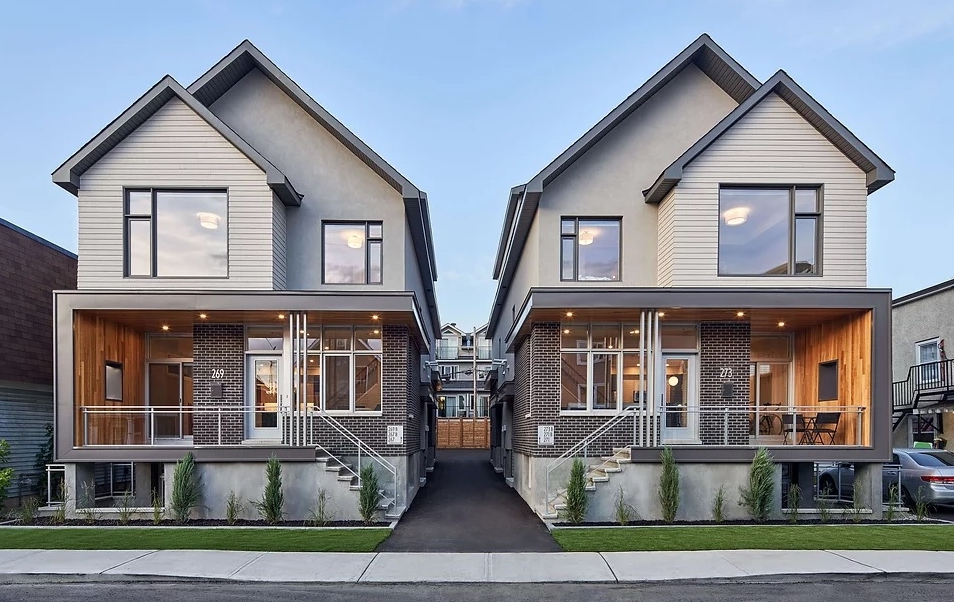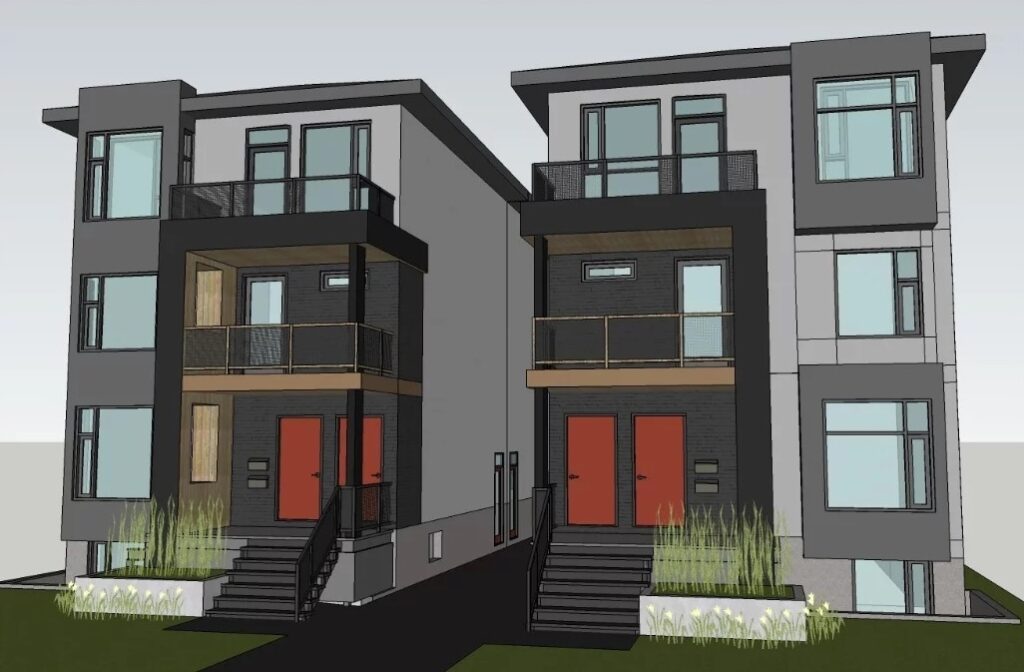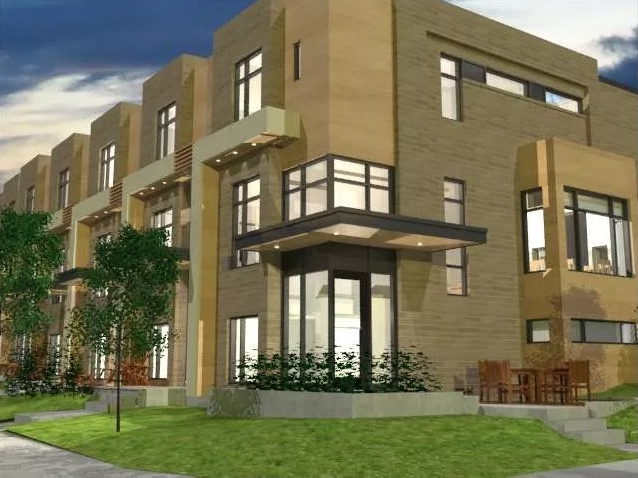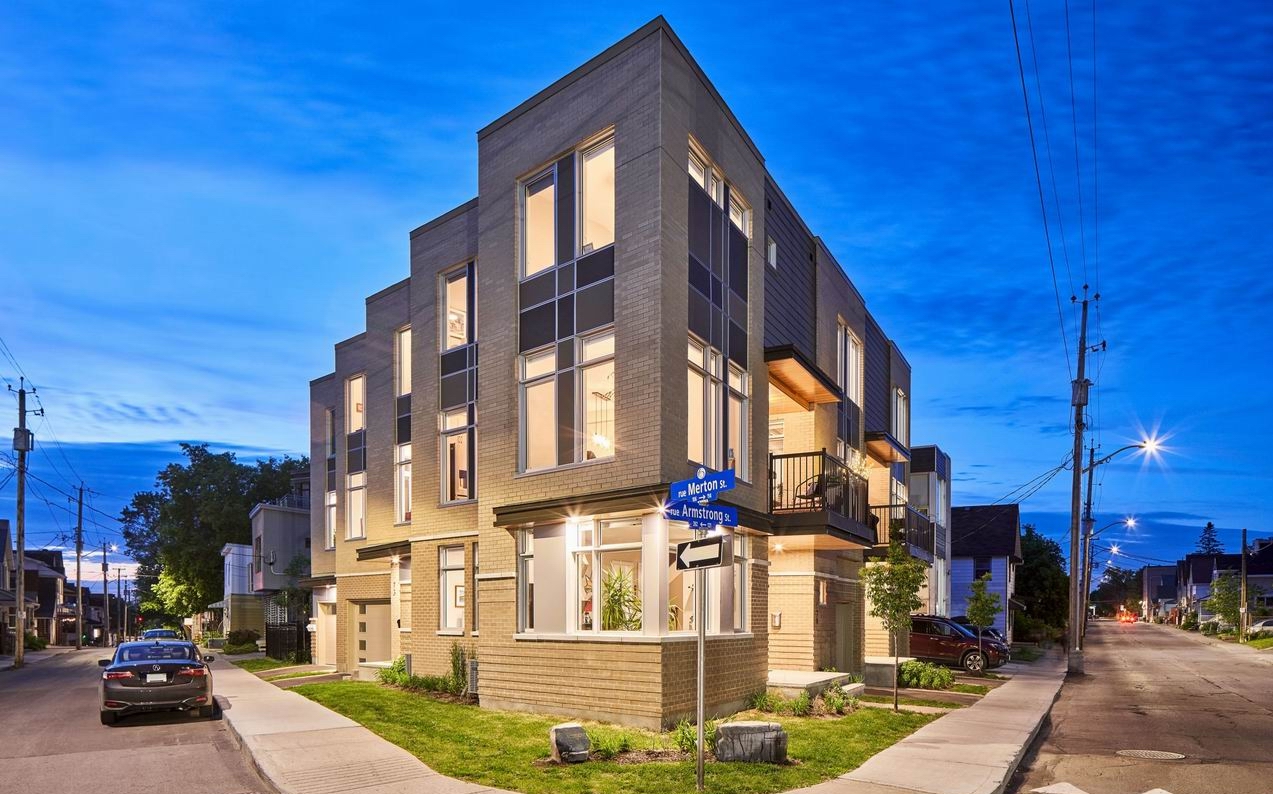Intensification in Ottawa has been a hot topic for several years. Ever since talk first began about updating the city’s Official Plan, those with an interest have explored the idea.
The Official Plan is the city’s guide to growth and development long term. It’s a legal document that becomes the reference point when making policy decisions. It was just updated last year and looks ahead 25 years, during which Ottawa is expected to grow by 400,000 people and 195,000 homes.
A key way the city expects to deal with this growth is through intensification of existing neighbourhoods, making them denser rather than simply expanding development out on the fringes of the suburbs.
Often, intensification in Ottawa has been seen as a bad thing, disrupting mature neighbourhoods where small, quaint homes are razed and replaced with bulky buildings that do not stick to approved zoning heights.
But architect Rosaline Hill, who specializes in infill development and has become an expert on navigating the city’s approvals process, sees intensification as an opportunity.
For the past three years, Hill has been studying intensification and how it could happen in Ottawa. Her goal is to see density in Ottawa’s urban neighbourhoods happen in a smart way, so that we transition our neighbourhoods into walkable communities where you don’t need to have a car to get to all the amenities your neighbourhood needs for healthy, happy residents.
Hill is the founder of Walkable Ottawa, co-founder of a recently launched community living initiative called Ottawa Cohousing, a multi-award-winning architect, an original member of the Urban Infill Council as part of the Greater Ottawa Home Builders’ Association, and a long-time urban advocate.
As part of an interview in the wake of being named Ottawa’s designer of the year at the 2021 Housing Design Awards, Hill shares her vision for and passion regarding our urban neighbourhoods. (This is an edited transcript.)

Q: What does good infill look like? What are the components?
A: In order to be environmentally responsible, infill should be intensification, No. 1. It’s not just replacing one single home with another single home, or even one home with two. We actually need to intensify more than that. So, intensification is a big deal.
Q: On a bigger scale, you’ve said good infill has to do with intensification in Ottawa. In what sense?
A: I’m studying intensification and building a simulator to understand and map out how intensification could happen in neighbourhoods under different regulatory scenarios.
And I’m seeing through that work that the way that neighbourhoods evolve has a lot to do with their intensification and their infill. If they’re able to intensify and evolve in a way that takes us from car-dependent lifestyles predominantly to neighbourhoods in which a walking lifestyle is a lovely possibility, then that’s really big.
So, if intensification just adds some people, makes the street slightly nicer, that’s one thing. But it’s a very, very different thing if a neighbourhood transitions to become delightfully walkable and complete.
If a neighbourhood is on a trajectory towards that, it needs to receive a lot more intensification, enough to populate small shops that you can walk to. There’s this ecosystem function that all these pieces need to be in place to get that full transition.
That kind of neighbourhood is very desirable; we like going on vacation to places like that, everyone would love to live in a neighbourhood like that, where you could have a car but you don’t really need to use it. And those neighbourhoods fundamentally are wildly more ecologically responsible than the neighbourhoods we have now.
Research has demonstrated that the health benefits of living in a neighbourhood like that are really significant. People actually live longer when they live in a neighbourhood like that. They’re healthier, they’re happier, they trust each other more, there’s lower rates of mental illness.
The benefits are so huge that I would like to go beyond just thinking about intensification and infill on one lot-by-lot kind of basis. We’re in an environmental crisis and we’re in a housing crisis. Some people would say we have an epidemic of loneliness, we certainly are quite socially isolated, even before COVID. Our neighbourhoods aren’t working that great.
So, if there’s the potential to get them to this entirely new and better place, then why on Earth wouldn’t we be doing that?

Q: How do you get past the NIMBY (not in my backyard) attitude?
A: I hope that we get past it by showing that we’re moving to a better place, because I think the people who are feeling really NIMBY about their neighbourhood are feeling that way for very valid reasons. So, No. 1, you have to validate that.
People are angry because they see infill in their neighbourhood that doesn’t have any logic or purpose behind it. Their neighbourhood is worse than it was before and nobody seems to be driving the ship.
There’s this prevailing sense of helplessness and frustration that’s building. But I would hope that if we get to the point where we can collectively plan a better way, one that is really easy on me as just anybody living in a neighbourhood, that we can overcome the NIMBY-ism.
For example, if I know my neighbourhood is transitioning to become fully walkable and complete, with a lovely tree canopy, walking paths to nice little coffee shops, it sounds nice, but it means there’s a lot of change in my neighbourhood and I hate change. But if it also means that I can sit in my house with my car and my lifestyle exactly as it is and allow my neighbourhood to change around me such that my neighbourhood has a fraction of the environmental impact in 25 years as it does today, that sounds pretty good.
“We’re right now heading off wildly in the wrong direction.”
Q: If everyone in the neighbourhood is thinking their little patch of property doesn’t have to change, where does the change actually come from?
A: It’s just as properties are bought and sold. The standard rate of change in a neighbourhood as a result of property sales opens up opportunities for developers. If they take those opportunities at the same rate that they’re taking them in a neighbourhood like Westboro — even slightly slower than that — but infill is done differently, with a real focus on intensification and neighbourhood renewal and transition, then it would happen.
It’s not as though certain citizens have to decide they’re going to give up their house for intensification. And there’s a certain amount of renewal that really needs to take place. There were houses that were built in the 1940s or ’50s or ’60s that have almost no insulation, that are in poor condition.
But we’re right now heading off wildly in the wrong direction. We’re taking down little houses and putting up a very big house, which for the family who lives in it is great, but we’re in a housing crisis. A similar building could contain often three or four dwelling units and that building could look exactly the same (as a single home).
There’s a majority of people who are cash-strapped and overextended and some research has shown that they’re buying more house than they would prefer to buy because the options for smaller aren’t available.
Close to walkable
Q: Does Ottawa have any good walkable neighbourhoods?
A: It’s pretty thin on the ground because we’re obviously a winter city and we’re not being very responsible about that. Hintonburg in summer, spring and fall would be a good example of a neighbourhood that’s functioning well as a walkable neighbourhood. They lack tree canopy, park space and they’re short on recreation space and all of those things need to improve, but generally speaking you can walk to things, you can live without a car there quite happily, except in winter, when you find yourself walking down the middle of the road and having to climb into a snowbank when a car comes.
Q: Will Greystone in Old Ottawa East or Zibi on the Ottawa River be close to walkable neighbourhoods?
A: Absolutely. And as we build new greyfield developments like that (greyfield typically refers to formerly developed land that has become outdated or underused, like the old E.B. Eddy plant straddling the Ottawa River that is being transformed into the mixed-use development Zibi), it’s essential that we make them that way. And I think the city will most likely ensure that they are built that way. We do need to be careful though when we build stuff like that that we’re not arm-twisting developers into building more commercial space than they can fill. There’s only so much commercial space needed in the city and we’ve got to be smart about how we use it and where we use it.
Q: What is your vision of the evolution of the city?
A: Towards walkable neighbourhoods, for sure, because it’s the single most significant thing we can do to reduce our emissions. It’s also a key to tackling our housing affordability problem, because lifestyles are so much more affordable in a walkable neighbourhood. A car-dependent lifestyle is fundamentally more expensive.
Growing in a way that allows us to live in walkable neighbourhoods is just more affordable for everyone. So, if we’ve got an affordability crisis going on we need to start thinking smart. Right now, we build the most expensive kind of urban places — the most expensive kind of housing would be single-family housing and apartment buildings.
The sweet spot for affordably housing ourselves is walkable neighbourhoods and small multi-unit buildings that are built out of wood frame, 3.5-storey max. So, let’s just do it.

Q: You specialize in missing middle development (in between single-family homes and high-rises). Can you describe that and why it’s important to you?
A: It’s missing because North America has had these regulatory strategies for housing that establish rights for singles and semis and triplexes and townhouses and describing all of these types of buildings and then assigning where you can and can’t build them.
Missing middle often defies those typologies. Missing middle buildings are often a combination, an example might be a back-to-back triplex. That’s not in the zoning. All of our regulations are typology-based.
When you’re talking about infill in existing neighbourhoods you often just have to be creative because you can’t necessarily get exactly the size of lot you want.
Infill fundamentally needs to be more creative, and those creative solutions often don’t fall into the typological categories. So, missing middle is the stuff that’s not getting built because it’s not allowed.
I really like to focus my work and my advocacy on neighbourhoods, and our neighbourhoods in Ottawa are two storeys plus a basement or three storeys plus a basement. And just coming back to the NIMBY thing, when people get upset about change in their neighbourhood, often they’re getting upset about height changes, height increases.
My research into development patterns in neighbourhoods is important because I can demonstrate that we can meet very significant intensification targets without increasing the height. If you can meet those targets without increasing the height, I don’t see why you would (increase height) in neighbourhoods. It’s upsetting to people. They like their two-storey neighbourhood the way it is.
Thinking inside the box
Q: Can you do that without having to take up more of a footprint? If you don’t go up, do you not have to go out?
A: It’s just allowing developers the think-inside-the-box solution. If, on a certain piece of property, they’re permitted to build a 3,000-square-foot amount of space plus a basement, that’s 4,000 square feet. In 4,000 square feet you can fit a lot of smaller units.
If you look demographically at the size of our households, there actually aren’t that many people who want a 3,000-square-foot house, but there’s an awful lot of people who are looking for a two-bedroom apartment and would love to live in a neighbourhood.
They’re relegated to a tower somewhere in a traffic island downtown and they might not be a downtown kind of person, they might be a neighbourhood kind of person. And so they’re saving up to buy a three-bedroom house in a neighbourhood so that they can live their dream.
But this opportunity is great, you don’t have to save, you can afford it now. It’s in a neighbourhood, in a small multi-unit building that some creative person has designed to fit beautifully into an existing neighbourhood.
There’s lots of demand for that and our housing market is constrained and not allowed to meet that demand. So, I do hope the city’s going to open up the opportunities and let a whole new era of housing play out.

Q: Do you think that’s part of the reason the city is now expressing interest in your project?
A: Yes. The city has been talking for years about new housing ideas and facilitating new kinds of intensification. The city is devoted to this general direction, but without modelling and simulation, it’s hard to get there, because you need to really understand the mechanics, all the pieces that go into the machine, to change the trajectory in really a very significant way.
Modelling and the Official Plan
Q: How does what you’re modelling and the approaches you’re looking at jive (or not) with the new Official Plan?
A: One of the scenarios that I’m running is close to the Official Plan in terms of the regulatory approach to neighbourhoods, and then I’m able to compare that with the target that the city with the Official Plan has put in place for intensification in neighbourhoods.
Right now, the two are just not going together at all, but before I jump to conclusions, I do hope that the city will work with me to vet the model to make sure that I’m making correct assumptions about the regulations they’re going to put in place before I conclude there’s a problem.
That work has yet to be done. But early indicators would be that there’s a disconnect between the way that they are considering regulating neighbourhoods and their targets for intensification and emissions. But they’re only just in the early stages of that so it would be unkind to be judgmental on that front.
Q: What do you hope this project will accomplish?
A: I’m hoping it will change the way that we zone cities. Municipalities are required to report back to the province how they’re going to meet their housing targets. In the past that was something that planners could do because they could understand how much new development land was going to come on the market and be zoned for housing and how much zoning they had allowed for apartment buildings and they could plan that out.
But now as we shift towards intensification and the evolution of neighbourhoods, cities don’t have a tool to plan and understand and make choices about their existing neighbourhoods in order to then report back to the province about their capacity to absorb new populations into existing neighbourhoods. So, I’m hoping this will become that kind of a tool.
“There’s actually not enough density to go around.”
Q: A lot of what we hear about intensification in Ottawa and densification comes across as really negative, yet you are in favour of it.
A: Yes, but not just intensification for the sake of intensification. It’s not a question of how can we pack in new people. I see intensification as an opportunity, and we can squander it, we can just let those people find places in towers or wherever and have a let’s-pack-them-in attitude, or we can see this as an opportunity, because if we use it as an opportunity to allow neighbourhoods that could be so much more live up to their potential, then that’s great.
When we sit down and understand the mechanism for change and the amount of density that you need to transition a neighbourhood over, there’s actually not enough density to go around. So, instead of thinking of density as a problem, really it’s a blessing.
People don’t often appreciate that their neighbourhoods are generally much lower density than they used to be. A neighbourhood built in the ’50s would have had an average household size of eight. Those buildings now have less than half that, so that neighbourhood is a third of the population it used to be. Tripling the population of that neighbourhood now is not intensification, that’s just getting us back where we were.

We’ve spent a long time with our tradition of planning in North America. This is a bit of an inflection point with housing and climate crisis — really having to think differently.
Understanding patterns
Q: Why do you have such dedication to infill advocacy?
A: Because I can, so therefore I am responsible.
I started off trying to understand development patterns in neighbourhoods because I was frustrated. And then when I realized that not only could I analyze and understand the patterns and the forces that generated the patterns, that by breaking that down I could then understand how to produce different patterns.
And different patterns that were possible would be more environmentally sustainable, more walkable, more socially engaging or socially dynamic, would provide a greater diversity of housing — so neighbourhoods at greater levels of equity and social justice.
I was surprised to see that in order to achieve any one of those things you necessarily had to achieve them all because as I analyzed the components, they were interdependent. So, if you want to get a walkable neighbourhood, your best chance is to work on those other pieces of the puzzle at the same time.
And realizing that, having sorted all that through, I was then holding information that is too valuable not to share. There’s potential there for enormous good.







